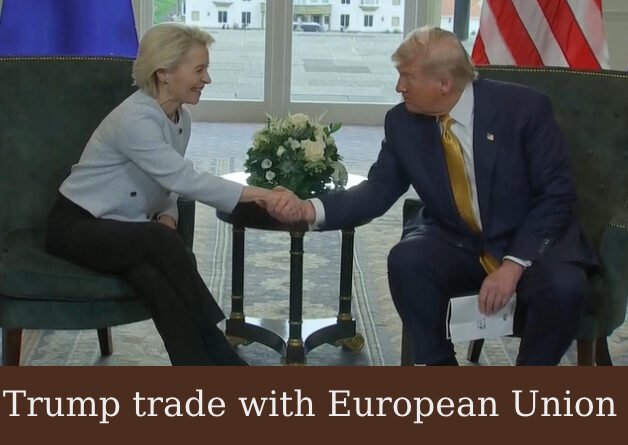Trump Trade With European Union: 15% Tariffs on EU Exports
Trump trade with European Union have reached a significant trade agreement, resolving months of tense negotiations between two of the world’s largest economic powers. The deal, brokered by President Donald Trump and European Commission President Ursula Von der Leyen, establishes a 15% US tariff on all EU goods—half the 30% rate Trump had previously threatened to impose.
The breakthrough came after high-stakes discussions at Trump’s Turnberry golf course in Scotland, where both leaders hailed the agreement as a win for stability in transatlantic trade. Trump emphasized that the Trump trade deal with the European Union would open EU markets to American exporters with zero tariffs on select products, while Von der Leyen praised the compromise as a crucial step toward reducing Europe’s reliance on Russian energy.
Under the terms, the EU pledged to invest $600 billion in the US, purchase billions in American military equipment, and spend $750 billion on US energy exports, including liquefied natural gas and nuclear fuels. “This is a huge deal,” Von der Leyen stated, acknowledging Trump’s tough but effective negotiation style. “He is a dealmaker, and this agreement benefits both sides.”
For Trump, the deal marks another step in his broader strategy to rebalance global trade and shrink the US trade deficit. The 15% tariff aligns with rates imposed on Japan but remains higher than the UK’s 10%. Economists estimate the new tariffs could generate around $90 billion in US revenue, based on last year’s trade volume of nearly $1 trillion between the two economies.
The agreement avoids a potential trade war, as the EU had prepared retaliatory tariffs on US goods like Boeing aircraft, automotive parts, and agricultural products. Trump’s steel and aluminum tariffs (set at 50%) remain unchanged, reflecting his “America First” approach.
While the Trump trade deal with the European Union eases immediate tensions, critics argue it may strain long-term EU-US relations. Meanwhile, Trump continues his global trade push, having already secured agreements with the UK, Japan, and Southeast Asian nations—though falling short of his ambitious “90 deals in 90 days” goal.
The deal’s geopolitical implications are notable, as Europe seeks to diversify energy sources away from Russia. Trump framed the partnership as a strategic victory, declaring, “This brings us closer together.” The EU, meanwhile, avoids the worst-case scenario of 30% tariffs on key exports like German machinery, French wine, and Italian luxury goods.
As Trump concludes his Scottish trip with a visit to his Aberdeen golf resort, the focus shifts to implementation—and whether this deal signals a lasting truce or merely a pause in the volatile world of Trump trade with the European Union.
Go To Main Page

